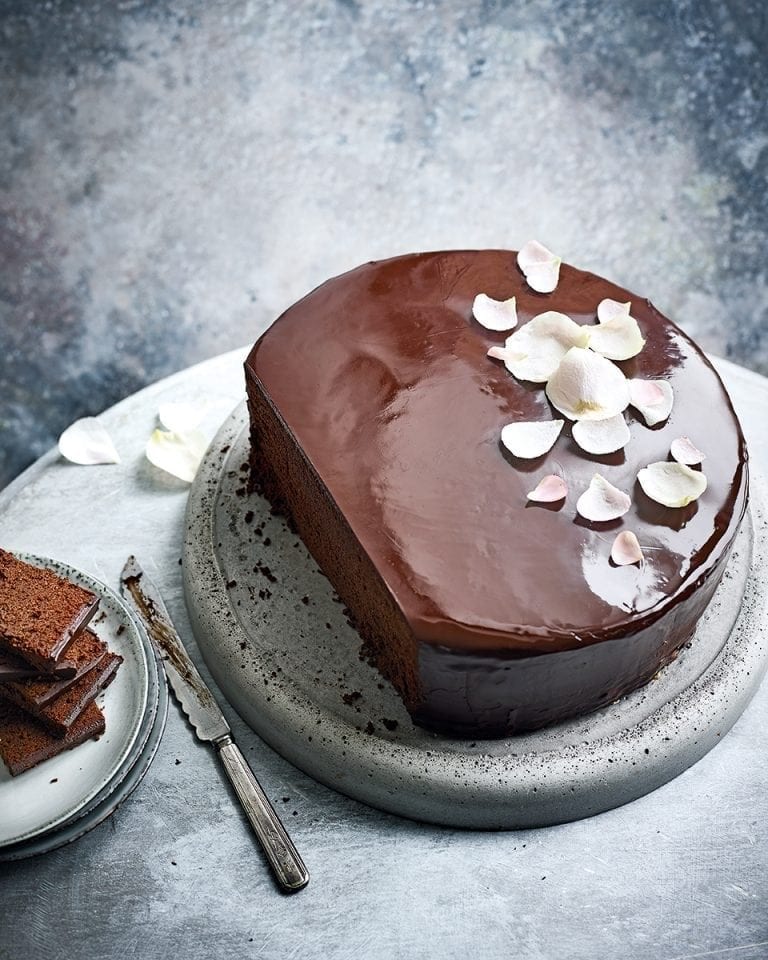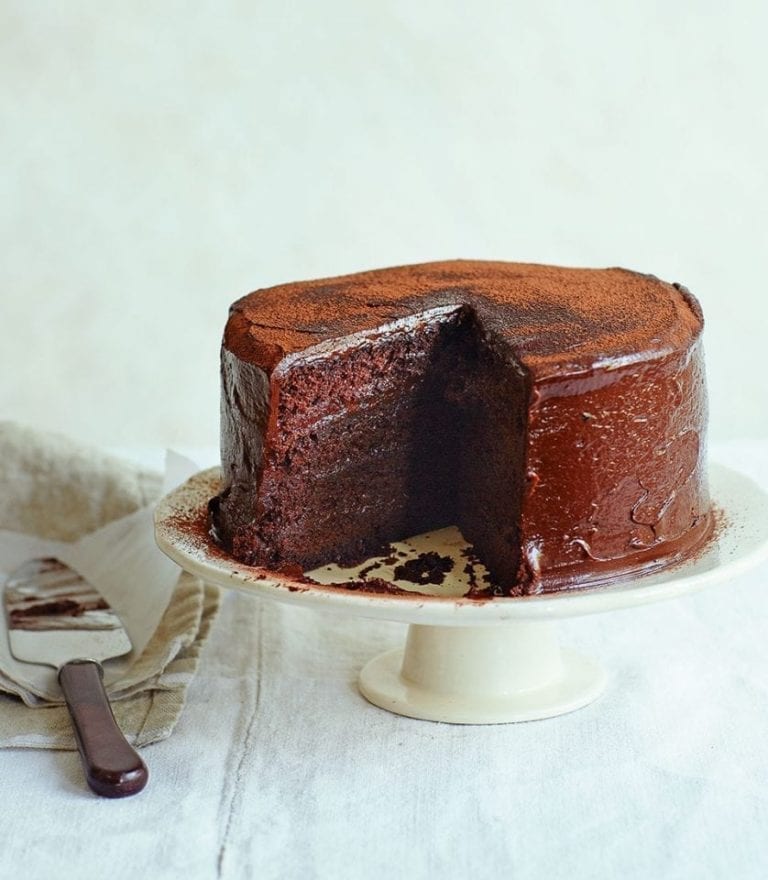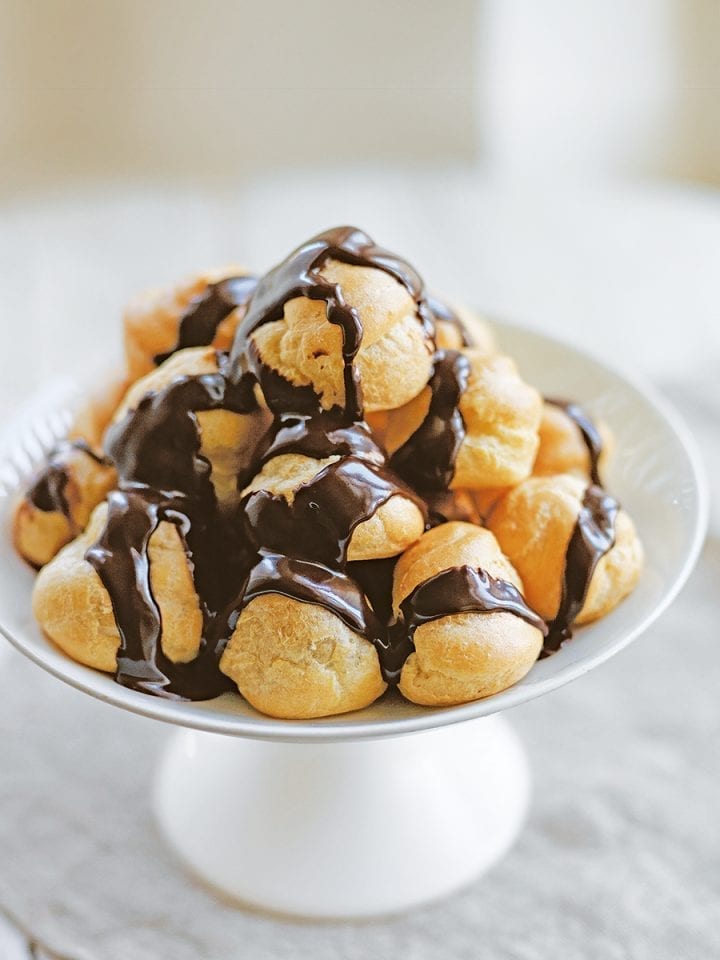How to make a sachertorte
Rich, moist and flourless – the Sachertorte, which is a popular Austrian chocolate cake, is the epitome of decadence. Follow Lorna Wing’s recipe for a three-tier sachertorte, or just one cake.

Handy tips before you make your sachertorte
- For a professional finishing touch, ice the cake again with at least two more coats of icing: put the leftover icing back over the pan of barely simmering water to melt again, then remove and allow to thicken, as before, and give the cake another coat. Chill until the icing has set, then repeat the process and chill for about 1 hour. Any spare icing on the trays can be saved and used at the last minute to disguise any marks – just melt it, then pass through a sieve into a small lidded container to remove any crumbs and refrigerate.
- If you’re thinking about making a triple decker sachertorte cake, do not attempt to make all three cakes in one go. Make them one at a time and cool completely before icing.
- To freeze your sachertorte layers, wrap the un-iced cake in a double layer of cling film, then in a double layer of foil and freeze for up to 2 months. Defrost overnight at room temperature before icing. Or you can make the cake up to 5 days ahead, wrap as above and keep in a cool, dry place. Ice the cake the day before and keep cool.
Sachertorte sizes and servings guide
15cm cake:
Serves: 10-15.
Hands-on time: 1 hour.
Oven time: 55-65 min, plus cooling and setting.
23cm cake:
Serves: 20-25.
Hands-on time: 1 hour 30 min.
Oven time: approx 1 hour 15-25 min, plus cooling and setting
30cm cake:
Serves: 35-45.
Hands-on time: 2 hours
Oven time: 2 hours 24 min to 3 hours, plus cooling and setting
Ingredients list
(For a 15cm cake)
- 225g dark chocolate, broken into squares
- 5 large eggs (4 separated, 1 whole)
- 175g caster sugar
- 110g ground almonds
- 1 level tbsp finely ground coffee
For the icing
- 225g dark chocolate, at least 51% cocoa solids, broken into squares
- 115g unsalted butter, cut into cubes
- 50g apricot jam for brushing
(For a 23cm cake)
- 400g dark chocolate, broken into squares
- 10 large eggs (2 whole and 8 separated)
- 350g caster sugar
- 225g ground almonds
- 1 rounded tbsp finely ground coffee
For the icing
- 400g dark chocolate, at least 51% cocoa solids, broken into squares
- 185g unsalted butter, cut into cubes
- 454g jar apricot jam
(For a 30cm cake)
- 1kg dark chocolate (70 per cent cocoa solids), broken into pieces
- 25 large free-range eggs (5 whole, 20 separated)
- 800g caster sugar
- 570g ground almonds
- 1 heaped tbsp espresso powder
For the icing
- 550g dark chocolate (70 per cent cocoa solids), broken into pieces
- 225g unsalted butter, cubed
- 110g smooth apricot jam
For all sizes of cake, you’ll also need…
- Loose-bottomed cake tin (with either 15cm, 23cm or 30cm base) with bases and sides greased & lined with a double thickness of non-stick baking paper, then tied with a double thickness of brown parcel paper round the outside with string to make a high collar
- Long-bladed palette knife
- Serving plate or cake board
How to make a sachertorte
- Heat the oven to 170C/150C fan/gas 3. Put a shallow ovenproof dish on the bottom shelf of the oven and fill with near-boiling water. Position the shelf for baking the cake about a third up from the bottom of the oven, just above the water.
- Melt the chocolate in a large heatproof bowl set over a medium pan of barely simmering water for 15-20 minutes, making sure the bowl doesn’t touch the water. Be careful not to overheat the chocolate or it will turn grainy.
- While the chocolate is melting, put the whole egg(s), egg yolks and sugar in a large mixing bowl. Beat with an electric mixer for about 10 minutes until thick and creamy. Using a large metal spoon, quickly stir the melted chocolate into the egg mixture, along with the almonds and coffee, until well mixed
- For 15cm and 23cm: Using an electric mixer, whisk the egg whites, until stiff but not dry. Using a large metal spoon, fold 2 heaped tablespoons of the egg whites into the chocolate mixture to loosen it. Quickly and lightly fold in the rest, using a figure-of-eight motion, until just combined. For 30cm: Using a stand mixer, whisk a third of the egg whites until stiff but not dry. Using a large metal spoon, fold a large spoonful of the egg whites into the chocolate mixture to loosen it. Quickly and lightly fold in the rest, using a figure-of-eight motion until just combined. Whisk the rest of the egg whites in 2 batches and fold in each batch straight after whisking.
- Carefully pour the mixture into the cake tin and lightly smooth the surface. Cover the top of the paper collar with a double thickness of extra-wide foil and make a hole in the centre the size of a 50p piece. Bake for required time (this will depend on the cake size – timings specified above).
- The cake is ready when well risen with a nicely set crust, and when a fine metal skewer pushed into the middle comes out clean. Remove from the oven, discard the foil and brown paper, cover the cake with a clean damp tea towel and leave to cool in the tin for 1 hour. Turn it out on to a wire rack to cool completely and remove the baking paper.
- For the icing, put the chocolate in a large heatproof bowl set over a medium pan of hot water over a low heat for 10-15 minutes until melted, making sure the bowl doesn’t touch the water.
- Add the butter, bit by bit, stirring gently with a heatproof plastic spatula until melted. Remove from the heat and set aside to cool until it has started to set to the consistency of thick double cream.
- Meanwhile, if the top of the cake is uneven, trim with a long-bladed knife, then upturn on to a wire rack to give a flat surface for icing. Brush away any loose crumbs and place a tray underneath to catch any icing drips.
- Melt the apricot jam in a small pan over a low heat for 3-4 minutes, then use a pastry brush to brush it over the top and sides of the cake to prevent any loose crumbs from spoiling the icing.
- Pour over a thin layer of icing and then, using a long-bladed palette knife, quickly and evenly smooth it over the top and sides and set the cake aside in a cool place (or fridge if you have room) for the icing to set.
- When the icing has set, use a small sharp knife dipped in very hot water to carefully cut the edge of the cake base away from the wire rack. Using a cake lifter or a palette knife and sturdy fish slice (and an extra pair of hands), transfer the cake to a serving plate or cake board.
- Decorate the cake however you wish. Use unsprayed rose petals brushed in egg white, then covered in caster sugar and left to dry, or edible gold leaf (from the baking aisle of larger supermarkets). Fresh flowers would look beautiful too. To serve, cut the cake into long slices, then cut each slice into portions.
Subscribe to our magazine
Food stories, skills and tested recipes, straight to your door... Enjoy 5 issues for just £5 with our special introductory offer.
Subscribe
Unleash your inner chef
Looking for inspiration? Receive the latest recipes with our newsletter

